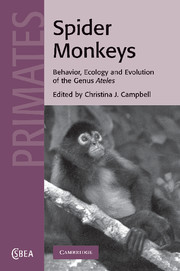Book contents
- Frontmatter
- Contents
- List of contributors
- Acknowledgements
- 1 Introduction
- Part I Taxonomy, phylogeny and evolution
- Part II Ecology
- 4 Diets of wild spider monkeys
- 5 Factors influencing spider monkey habitat use and ranging patterns
- 6 Spider monkeys as seed dispersers
- Part III Behavior and reproduction
- Part IV Interactions with humans
- Index
- References
6 - Spider monkeys as seed dispersers
Published online by Cambridge University Press: 05 May 2010
- Frontmatter
- Contents
- List of contributors
- Acknowledgements
- 1 Introduction
- Part I Taxonomy, phylogeny and evolution
- Part II Ecology
- 4 Diets of wild spider monkeys
- 5 Factors influencing spider monkey habitat use and ranging patterns
- 6 Spider monkeys as seed dispersers
- Part III Behavior and reproduction
- Part IV Interactions with humans
- Index
- References
Summary
Introduction
Plants, which cannot move on their own, must rely on external forces such as wind, water, or interactions with motile organisms for pollination and seed dispersal. Dispersal away from the parent plant is vital as seeds are unlikely to survive predation or disease if they are not moved away from the crown of the parent. Additionally, the layered canopy of the tropical forest prevents as much as 98% of sunlight from reaching the ground (Gentry, 1983). Tropical canopy plants are thus under selective pressure to produce relatively large seeds, as their seedlings often require considerable energy reserves to survive in the forest understory. Large seeds are not easily dispersed by wind or water, and most tropical tree species use the vertebrate gut as a vector for dispersal (Gentry, 1983). These seeds are encased in fleshy, nutritious fruits that are swallowed by animals and defecated elsewhere, a dispersal strategy known as endozoochory (van der Pijl, 1957).
Frugivorous primates play important roles in this interaction. With their relatively large body sizes (compared with most birds, for example) and their long day ranges, primates are among the most effective dispersers of the large seeds produced by most tropical trees (Gautier-Hion et al., 1983; Bourliere, 1985; Garber, 1986; Leiberman and Lieberman, 1986; White, 1986; Gautier-Hion and Michaloud, 1989; Chapman, 1989, 1995). As a result, there could be serious community-level effects should these seed dispersers be removed from the ecosystem (Howe, 1977, 1984; Gilbert, 1980; Howe and Smallwood, 1982; Janzen, 1985; Terborgh, 1986; Cox et al.
- Type
- Chapter
- Information
- Spider MonkeysThe Biology, Behavior and Ecology of the Genus Ateles, pp. 155 - 182Publisher: Cambridge University PressPrint publication year: 2008
References
- 13
- Cited by

